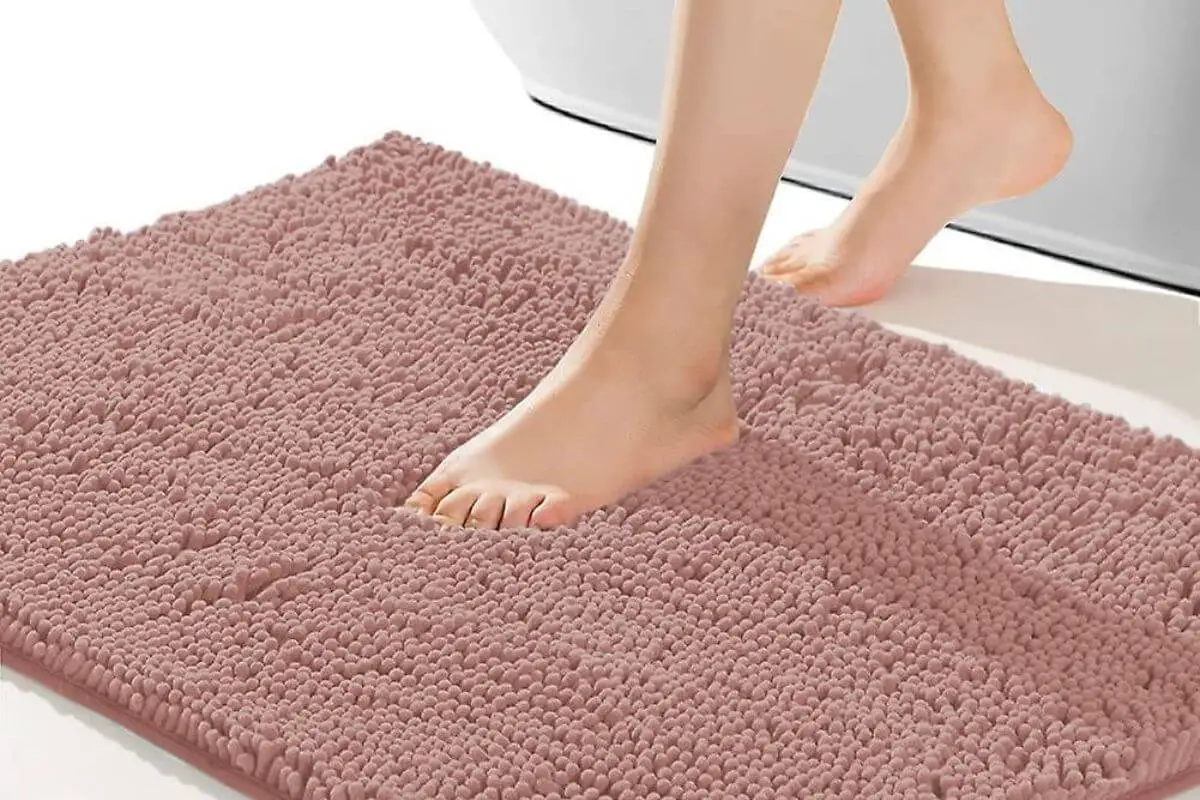Bath mats with suction cups are a common fixture in bathrooms, serving the essential purpose of providing a non-slip surface in wet areas. Over time, these mats can accumulate dirt, soap scum, and mildew, making them appear dingy and potentially unsightly. Fortunately, you can effectively clean your bath mat with suction cups using vinegar, a natural and cost-effective cleaning solution. In this comprehensive guide, we’ll walk you through the step-by-step process of cleaning your bath mat with suction cups using vinegar to restore its cleanliness and safety.
Why Clean Your Bath Mat with Vinegar?
Vinegar is a versatile and natural cleaning agent with various benefits:
Effective Disinfectant:
Vinegar has antibacterial and antifungal properties, making it a powerful disinfectant.
Stain and Odor Remover:
It can help remove stains and neutralize odors caused by mildew and bacteria.
Eco-Friendly:
Vinegar is an eco-friendly and non-toxic cleaning solution, making it safe for both you and the environment.
Cost-Effective:
It’s an affordable cleaning option that can save you money on specialized cleaning products.

What You’ll Need
Before you start, gather the following items:
Bath Mat:
The one you want to clean, equipped with suction cups.
White Vinegar:
Regular distilled white vinegar works best for this purpose.
A Tub or Basin:
Large enough to submerge the bath mat completely.
A Soft Brush or Cloth:
Use a soft-bristle brush or a cloth to scrub the mat.
Warm Water:
To fill the tub or basin for soaking.
Dishwashing Liquid (Optional):
For additional cleaning power.
A Towel or Drying Rack:
To dry the mat after cleaning.
Step-by-Step Cleaning Process
Follow these steps to clean your bath mat with suction cups using vinegar:
1. Prepare the Soaking Solution
- Fill the tub or basin with warm water. You want enough water to fully submerge the bath mat.
- Add one to two cups of white vinegar to the water. The exact amount may vary based on the size of your bath mat and the level of cleaning needed.
- If the bath mat has stubborn stains, consider adding a few drops of dishwashing liquid to the solution for additional cleaning power.
2. Submerge the Bath Mat
- Place the bath mat with suction cups into the vinegar and water solution, ensuring it is completely submerged.
3. Soak the Mat
- Allow the bath mat to soak for at least 30 minutes. For heavily soiled or stained mats, you can extend the soaking time to a few hours or overnight.
4. Scrub and Rinse
- After soaking, use a soft brush or cloth to scrub the bath mat, paying particular attention to the areas with suction cups and any visible stains.
- If needed, use an old toothbrush or a small brush to clean between the suction cups and along the edges.
- Rinse the bath mat thoroughly under running water to remove any vinegar residue.
5. Dry the Mat
- Gently shake the bath mat to remove excess water.
- Hang the mat on a drying rack or lay it flat on a towel to air dry completely. Make sure it dries thoroughly to prevent mildew from returning.
6. Reinstall
- Once the bath mat is completely dry, reinstall it in your bathroom, ensuring that the suction cups adhere securely to the floor.
Maintenance Tips
To keep your bath mat clean and prevent excessive buildup, consider these maintenance tips:
Regular Cleaning:
Clean your bath mat with vinegar every few weeks, even if it doesn’t appear dirty. This prevents the accumulation of soap scum and mildew.
Hang to Dry:
After each use, hang the bath mat to dry instead of leaving it on a wet bathroom floor. This helps extend its lifespan.
Wash Your Feet:
Encourage family members to wash their feet before stepping onto the bath mat. This reduces the introduction of dirt and oils.
Use a Towel:
Place a towel on the bath mat if someone in your household has just stepped out of the shower or bath to further minimize moisture on the mat.
Inspect Regularly:
Periodically check for signs of wear and tear on your bath mat, such as loose suction cups or cracks, and replace it when necessary.
By following these steps and maintaining your bath mat properly, you can ensure that it remains clean, safe, and in good condition for a long time. Cleaning with vinegar is an excellent way to maintain your bath mat’s appearance and hygiene without the use of harsh chemicals.
Additional Uses of Vinegar
Apart from cleaning your bath mat, vinegar has various other cleaning applications within your bathroom:
Toilet Cleaning:
Vinegar is an effective and natural toilet bowl cleaner. Pour a cup of vinegar into the bowl, let it sit for a while, scrub with a toilet brush, and flush for a sparkling clean toilet.
Showerhead Cleaning:
If your showerhead is clogged with mineral deposits, submerge it in a vinegar solution or tie a plastic bag filled with vinegar around it overnight to remove the buildup.
Mirror and Glass Cleaning:
Diluted vinegar can be used to clean bathroom mirrors and glass surfaces, leaving them streak-free and shiny.
Tile and Grout Cleaning:
A mixture of vinegar and water is excellent for cleaning bathroom tiles and grout. It can dissolve soap scum and mold, making your tiles look like new.
Faucet Cleaning:
Soak a cloth in vinegar and wrap it around faucet fixtures to remove mineral deposits and restore shine.
Safety Precautions
While vinegar is a safe and natural cleaning solution, it’s essential to take some safety precautions:
- Always use white distilled vinegar, which is the safest type for cleaning.
- Ensure the bathroom is well-ventilated during the cleaning process to avoid inhaling vinegar fumes.
- Be cautious when mixing vinegar with other cleaning products, as it can react with certain chemicals to produce harmful fumes.
- Avoid using vinegar on natural stone surfaces like marble and granite, as it can etch the stone.
- If you have any respiratory conditions or allergies, consider wearing a mask when using vinegar for cleaning.
In Conclusion
Cleaning your bath mat with suction cups using vinegar is an eco-friendly, cost-effective, and highly effective method to maintain a clean and safe bathroom environment. By following the steps outlined in this guide, you can easily remove dirt, mildew, and stains from your bath mat, ensuring that it remains a functional and attractive addition to your bathroom. Additionally, vinegar has a range of other cleaning applications within the bathroom, making it a versatile and natural cleaning solution. Regular cleaning and maintenance will keep your bathroom a clean and welcoming space for you and your family.
Certainly, here are some frequently asked questions (FAQs) regarding cleaning bath mats with suction cups using vinegar:
FAQS
1. How does vinegar clean a bath mat with suction cups?
Vinegar is an effective cleaning agent due to its antibacterial and antifungal properties. It helps dissolve dirt, soap scum, and mildew, making it an excellent choice for cleaning bath mats with suction cups.
2. Can I use any type of vinegar to clean my bath mat?
It’s recommended to use white distilled vinegar for cleaning your bath mat. This type of vinegar is safe and effective for cleaning purposes.
3. How long should I soak my bath mat in the vinegar solution?
Soak your bath mat for at least 30 minutes, but you can extend the soaking time for heavily soiled or stained mats, even up to several hours or overnight if needed.
4. Can I use vinegar to clean other bathroom surfaces?
Yes, vinegar is a versatile cleaning solution for various bathroom surfaces, including toilets, showerheads, mirrors, glass, tiles, grout, and faucet fixtures. It effectively removes stains, mineral deposits, and soap scum.
5. Is vinegar safe for the environment?
Yes, vinegar is an eco-friendly and non-toxic cleaning solution, making it safe for both you and the environment. It’s a great alternative to harsh chemical cleaners.
6. Are there any precautions to take when using vinegar for cleaning?
Ensure proper ventilation when using vinegar to avoid inhaling fumes. Be cautious when mixing vinegar with other cleaning products, as it can react with certain chemicals. Avoid using vinegar on natural stone surfaces like marble and granite, as it can etch the stone.
By following these FAQs and the comprehensive cleaning guide, you can effectively and safely clean your bath mat with suction cups using vinegar, keeping your bathroom clean and hygienic.




